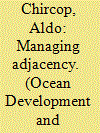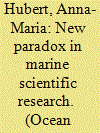| Srl | Item |
| 1 |
ID:
108589


|
|
|
|
|
| Publication |
2011.
|
| Summary/Abstract |
The Third United Nations Conference on the Law of the Sea (1973-1982) struck a difficult compromise between the definition of the outer limits of the extended continental shelf (ECS) in relation to the international seabed area (the Area) and the making of payments and contributions by the coastal state in relation to production activities on its ECS in Article 82. The implementation of Article 82 underscores a broader and more far-reaching relationship between the continental shelf, and the ECS in particular, and the Area. In some regions there may be a relationship between the exclusive economic zone and the Area, where there is no ECS. Effectively, the relationship translates into realities and expectations of good neighborliness. This article examines this relationship and the possible approaches for the management of identified challenges.
|
|
|
|
|
|
|
|
|
|
|
|
|
|
|
|
| 2 |
ID:
108593


|
|
|
|
|
| Publication |
2011.
|
| Summary/Abstract |
This article addresses several questions pertaining to Canada's extended continental shelf in the Arctic Ocean. How well is Canada positioned to meet the 2013 timeline? How are the current practices of the Commission on the Limits of the Continental Shelf likely to impact Canada's submission? What concerns does Article 82 of the 1982 UN Convention on the Law of the Sea pose for Canada? The article concludes that Canada is well positioned to meet the 2013 deadline, but that the commission is ill-prepared to provide a timely response. Article 82 presents a particularly thorny problem as the details on which such arrangements must be based will not be fully known until commercial production begins, which is decades away.
|
|
|
|
|
|
|
|
|
|
|
|
|
|
|
|
| 3 |
ID:
108591


|
|
|
|
|
| Publication |
2011.
|
| Summary/Abstract |
Concerns about the negative effects of marine scientific research are in clear juxtaposition to the beneficial role that scientific knowledge plays in enhancing the understanding of the oceans and protecting the marine environment. This presents a regulatory paradox that is examined in this article in light of the legal framework in the 1982 United Nations Convention on the Law of the Sea. The article traces how these general principles in the Convention are elaborated in soft law instruments for the promotion of environmentally sustainable research practices. It also looks at an example of state practice in this area by examining regulatory measures instituted in the Canadian Endeavour Hydrothermal Vent Marine Protected Area.
|
|
|
|
|
|
|
|
|
|
|
|
|
|
|
|
| 4 |
ID:
108590


|
|
|
|
|
| Publication |
2011.
|
| Summary/Abstract |
The establishment of the outer limits of the continental shelf not only involves the rights and interests of coastal states, but also the interests of the international community as a whole. This article examines this balance between coastal states' assertions of their outer continental shelf limits and the common heritage of mankind.
|
|
|
|
|
|
|
|
|
|
|
|
|
|
|
|
| 5 |
ID:
108592


|
|
|
|
|
| Publication |
2011.
|
| Summary/Abstract |
This article examines China's domestic legal regime for the prevention of vessel source pollution. It pays special attention to the recently adopted Regulation on Prevention and Control of Marine Pollution from Vessels. Potential challenges and emerging issues that China has to confront are addressed, including: application of the legislation to disputed sea areas between China and its neighbors, freedom of navigation in the exclusive economic zone, reduction of emission from ships, and prevention of invasive species from ballast water.
|
|
|
|
|
|
|
|
|
|
|
|
|
|
|
|
| 6 |
ID:
108588


|
|
|
|
|
| Publication |
2011.
|
| Summary/Abstract |
Several of the summaries of recommendations of the Commission on the Limits of the Continental Shelf contain recommendations involving the application of the provisions of Article 76 of the 1982 UN Convention on the Law of the Sea with respect to a class of morphological features that can best be described as seafloor highs. The application of these provisions requires the classification of such features into one of the three categories of seafloor highs: oceanic ridges of the deep ocean floor, submarine ridges, and submarine elevations that are natural components of the continental margin. The summaries of the CLCS recommendations provide guidance on the approach that has been adopted for the application of these provisions. Furthermore, the summaries give insight into the principles by which the CLCS is guided in considering the submerged prolongation of the landmass of a coastal state and the delineation of the outer limits of its continental shelf beyond 200 nautical miles, and the importance of determining the foot of the continental slope at its base in this connection.
|
|
|
|
|
|
|
|
|
|
|
|
|
|
|
|